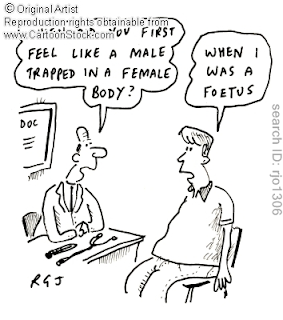This information was handed out to us in class today, since it addressed my subtopic I thought it would be great to put it up on our blog!
A.) A strong persistent cross-gender identification (not merely a desire for any perceived cultural advantages of being the other sex). In children, the disturbance is manifested by four (or more) of the following:
1. Repeatedly stated desire to be, or insistence that he or she is, the other sex.
2. In boys, preference for cross-dressing or simulating female attire; in girls, insistence on wearing only stereotypical masculine clothing.
3. Strong and persistent preferences for cross-sex roles in make believe play or persistent fantasies of being the other sex.
4. Intense desire to participate in the stereotypical games and pastimes of the other sex.
5. Strong preference for playmates of the other sex.
B.) Persistent discomfort with his or her sex or sense of inappropriateness in the gender role of that sex.
In children, the disturbance is manifested by any of the following:
In boys, assertion that his penis or testes are disgusting or will disappear or assertion that it would be better not to have a penis, or aversion toward rough-and-tumble play and rejection of male stereotypical toys, games, and activities.
In girls, rejection of urinating in a sitting position, assertion that she has or will grow a penis, or assertion that she does not want to grow breasts or menstruate, or marked aversion toward normative feminine clothing.
In adolescents and adults, the disturbance is manifested by symptoms such as preoccupation with getting rid of primary and secondary sex characteristics (e.g., request for hormones, surgery, or other procedures to physically alter sexual characteristics to simulate the other sex) or belief that he or she was born the wrong sex.
C.) The disturbance is not concurrent with physical intersex condition.
D.) The disturbance causes clinically significant distress or impairment in social, occupational, or other important areas of functioning.
Diagnostic Criteria for GID in the DSM-IV
-Kati



















